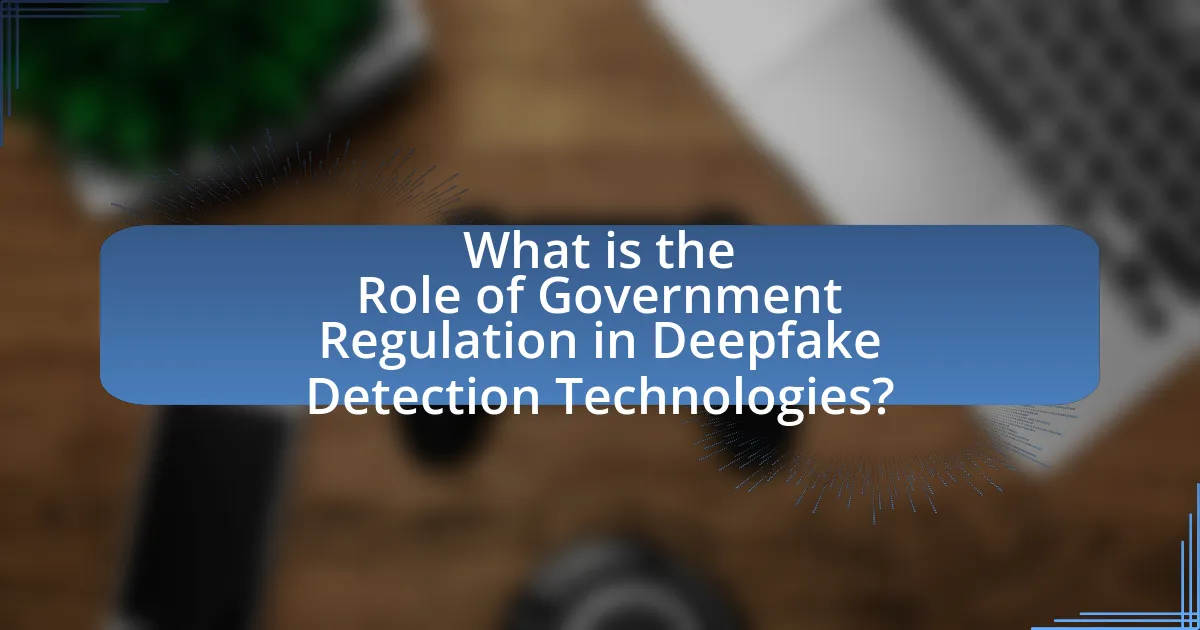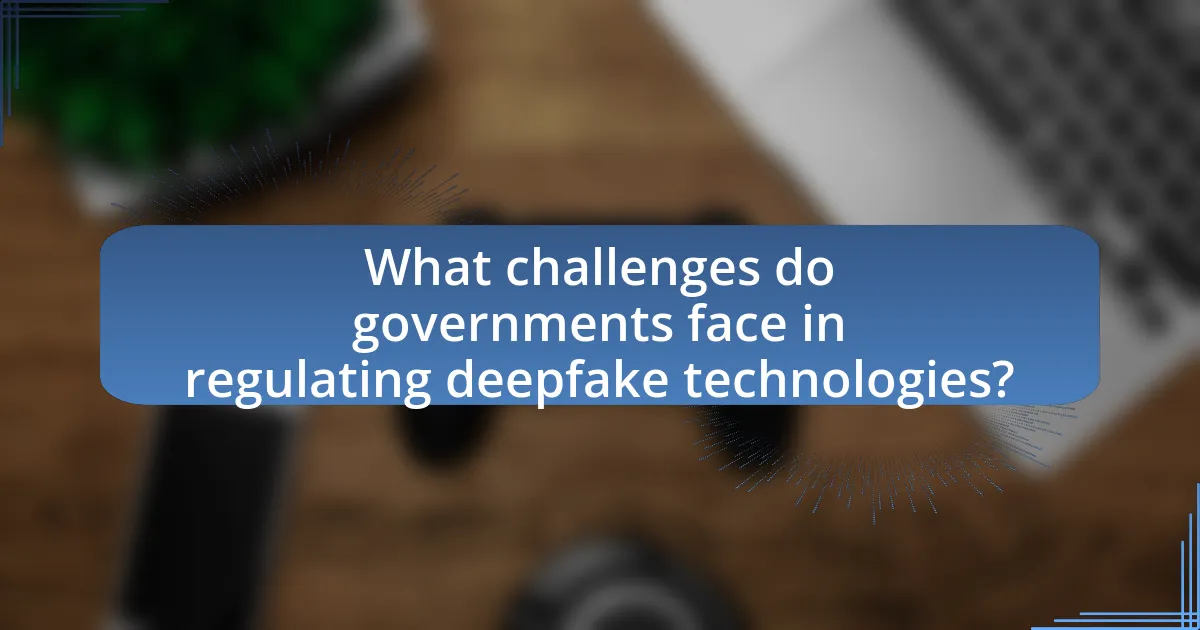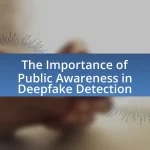The article examines the critical role of government regulation in the development and implementation of deepfake detection technologies. It highlights the necessity of legal frameworks to ensure ethical standards, protect public safety, and mitigate risks associated with deepfakes, such as misinformation and identity theft. The discussion includes current regulations in various countries, the challenges governments face in keeping pace with technological advancements, and the ethical considerations involved in regulating these technologies. Additionally, it explores future trends in regulation, the importance of international cooperation, and best practices for effective governance in the realm of deepfake detection.

What is the Role of Government Regulation in Deepfake Detection Technologies?
Government regulation plays a crucial role in the development and implementation of deepfake detection technologies by establishing legal frameworks that guide ethical use and protect against misuse. Regulations can mandate transparency in the creation and dissemination of deepfakes, ensuring that users are informed about the authenticity of content. For instance, the U.S. Congress has considered legislation aimed at addressing the risks posed by deepfakes, highlighting the need for accountability and the protection of individuals from potential harm, such as misinformation and identity theft. Furthermore, regulatory bodies can support research and development in detection technologies by providing funding and resources, thereby enhancing the effectiveness of these tools in combating malicious deepfake applications.
Why is government regulation necessary for deepfake detection technologies?
Government regulation is necessary for deepfake detection technologies to ensure ethical standards and protect public safety. As deepfakes can be used to spread misinformation, manipulate public opinion, and damage reputations, regulation helps establish guidelines for the responsible use of these technologies. For instance, the rise of deepfake incidents has led to concerns about their impact on elections and social trust, prompting calls for legal frameworks to address these challenges. Studies indicate that without regulation, the misuse of deepfake technology could escalate, leading to significant societal harm, as evidenced by incidents where deepfakes have been used in harassment and fraud.
What are the potential risks associated with deepfakes that warrant regulation?
Deepfakes pose significant risks that warrant regulation due to their potential to facilitate misinformation, identity theft, and reputational harm. Misinformation can lead to the manipulation of public opinion, as seen in instances where deepfakes have been used to create false political statements, undermining democratic processes. Identity theft risks arise when individuals’ likenesses are used without consent, potentially leading to fraud or harassment. Additionally, deepfakes can cause reputational damage, as individuals may find themselves falsely depicted in compromising situations, impacting their personal and professional lives. These risks highlight the urgent need for regulatory frameworks to mitigate the harmful effects of deepfakes on society.
How do deepfakes impact public trust and safety?
Deepfakes significantly undermine public trust and safety by spreading misinformation and creating realistic but false representations of individuals. The proliferation of deepfake technology has led to increased skepticism regarding the authenticity of video and audio content, making it difficult for individuals to discern truth from fabrication. A study by the University of California, Berkeley, found that 85% of participants expressed concern about the potential for deepfakes to mislead the public, highlighting the erosion of trust in media sources. Furthermore, deepfakes pose safety risks by enabling malicious activities such as identity theft, harassment, and political manipulation, which can have real-world consequences. The potential for deepfakes to disrupt social cohesion and incite violence underscores the urgent need for effective government regulation and detection technologies to mitigate these risks.
What are the current government regulations surrounding deepfake technologies?
Current government regulations surrounding deepfake technologies vary by country but generally focus on issues of misinformation, privacy, and consent. In the United States, for example, several states have enacted laws that specifically address the malicious use of deepfakes, such as California’s law prohibiting the use of deepfakes to harm or defraud individuals, which took effect in 2019. Additionally, the proposed DEEPFAKES Accountability Act aims to require disclosures when deepfakes are used in political advertising. In the European Union, the Digital Services Act includes provisions that could impact the use of deepfake technologies by imposing stricter regulations on platforms that host user-generated content. These regulations are designed to mitigate the risks associated with deepfakes, including the potential for fraud and the spread of false information.
Which countries have implemented regulations on deepfakes?
Countries that have implemented regulations on deepfakes include the United States, Canada, the United Kingdom, and Australia. In the United States, various states have enacted laws targeting deepfake technology, particularly in relation to election integrity and non-consensual pornography. For instance, California’s law prohibits the use of deepfakes to harm or defraud individuals. Canada has proposed regulations under its Digital Charter to address the misuse of deepfakes. The United Kingdom has considered deepfake regulations as part of its Online Safety Bill, aiming to tackle harmful content online. Australia has also introduced measures to combat the malicious use of deepfakes, particularly in the context of misinformation and privacy violations.
What specific laws or guidelines exist for deepfake detection technologies?
Specific laws and guidelines for deepfake detection technologies include the Malicious Deep Fake Prohibition Act of 2018 in the United States, which criminalizes the use of deepfakes for malicious purposes, and the EU’s Digital Services Act, which mandates platforms to take action against harmful content, including deepfakes. These regulations aim to address the risks associated with deepfakes, such as misinformation and privacy violations, by establishing legal frameworks that hold creators and distributors accountable. The effectiveness of these laws is supported by ongoing discussions in legal and technological communities regarding the need for robust detection methods and ethical standards in AI usage.
How do government regulations influence the development of deepfake detection technologies?
Government regulations significantly influence the development of deepfake detection technologies by establishing legal frameworks that dictate the ethical use of artificial intelligence and media. These regulations can drive innovation by creating a demand for reliable detection tools to comply with laws aimed at preventing misinformation and protecting privacy. For instance, the introduction of laws like the Malicious Deep Fake Prohibition Act in the United States has prompted tech companies to invest in developing advanced detection algorithms to avoid legal repercussions. Additionally, regulatory bodies often fund research initiatives focused on improving detection methods, thereby accelerating technological advancements in this field.
What role do regulations play in fostering innovation in detection technologies?
Regulations play a crucial role in fostering innovation in detection technologies by establishing standards that ensure safety, efficacy, and ethical use. These regulations create a framework within which companies can develop new technologies, as they provide clarity on compliance requirements and encourage investment in research and development. For instance, the European Union’s General Data Protection Regulation (GDPR) has prompted advancements in privacy-preserving detection technologies, as companies seek to align their innovations with legal standards. This regulatory environment not only mitigates risks associated with misuse but also incentivizes the creation of robust solutions that address societal concerns, thereby driving innovation in the field.
How do regulations affect the collaboration between tech companies and government agencies?
Regulations significantly shape the collaboration between tech companies and government agencies by establishing legal frameworks that dictate the parameters of their interactions. These regulations can facilitate partnerships by providing clear guidelines for data sharing, privacy protection, and compliance standards, which are essential for developing technologies like deepfake detection. For instance, the General Data Protection Regulation (GDPR) in Europe mandates strict data handling practices, compelling tech companies to align their operations with government expectations, thereby fostering a collaborative environment focused on ethical technology use. Conversely, overly stringent regulations may hinder innovation by imposing excessive compliance costs and operational limitations, potentially discouraging tech companies from engaging with government initiatives. This dynamic illustrates how regulations can either enhance or obstruct collaborative efforts, depending on their design and implementation.

What challenges do governments face in regulating deepfake technologies?
Governments face significant challenges in regulating deepfake technologies due to the rapid pace of technological advancement and the difficulty in defining legal frameworks that can effectively address the unique characteristics of deepfakes. The evolving nature of deepfake creation tools complicates enforcement, as these technologies can be easily accessed and utilized by individuals with minimal technical expertise. Additionally, the potential for misuse in misinformation campaigns and privacy violations raises concerns about balancing regulation with freedom of expression. For instance, a report by the European Commission highlights that existing laws may not adequately cover the nuances of deepfake content, making it challenging for authorities to prosecute malicious uses effectively. Furthermore, the global nature of the internet complicates jurisdictional issues, as deepfake creators can operate across borders, evading local regulations.
How do technological advancements complicate regulation efforts?
Technological advancements complicate regulation efforts by rapidly evolving the landscape of digital content creation, making it difficult for regulatory frameworks to keep pace. For instance, the emergence of deepfake technology allows for the creation of highly realistic manipulated videos, which can be used maliciously, yet existing laws often lag behind these innovations. A study by the Brookings Institution highlights that the speed of technological change outstrips the ability of lawmakers to understand and regulate these technologies effectively, leading to gaps in legal protections and enforcement mechanisms.
What are the limitations of current regulatory frameworks in addressing deepfakes?
Current regulatory frameworks face significant limitations in effectively addressing deepfakes due to their inability to keep pace with rapid technological advancements. Existing laws often lack specificity regarding the definition of deepfakes, leading to challenges in enforcement and prosecution. For instance, many jurisdictions do not have clear guidelines on what constitutes harmful or malicious use of deepfake technology, resulting in a legal gray area that can be exploited. Additionally, the global nature of the internet complicates enforcement, as deepfake creators can operate across borders, evading local regulations. Furthermore, current frameworks often focus on reactive measures rather than proactive prevention, failing to address the root causes of deepfake creation and dissemination. These limitations hinder the ability of regulatory bodies to protect individuals and society from the potential harms associated with deepfakes, such as misinformation and privacy violations.
How can governments keep pace with rapidly evolving deepfake technologies?
Governments can keep pace with rapidly evolving deepfake technologies by implementing robust regulatory frameworks that promote transparency and accountability in digital content creation. These frameworks should include clear definitions of deepfakes, establish legal consequences for malicious use, and mandate disclosure requirements for synthetic media. For instance, the European Union’s proposed Digital Services Act aims to address misinformation and harmful content, including deepfakes, by holding platforms accountable for the content they host. Additionally, governments can invest in research and development of advanced detection technologies, collaborating with academic institutions and tech companies to stay ahead of emerging threats. This proactive approach is essential, as deepfake technology is advancing rapidly, with a report from Deeptrace indicating a 100% increase in deepfake videos online from 2018 to 2019, highlighting the urgency for effective governmental action.
What ethical considerations arise in the regulation of deepfake detection technologies?
Ethical considerations in the regulation of deepfake detection technologies include privacy concerns, the potential for misuse, and the implications for free speech. Privacy concerns arise as detection technologies may require access to personal data, which can infringe on individual rights. The potential for misuse is significant, as these technologies could be employed to censor legitimate content or target individuals unfairly. Furthermore, the regulation of deepfake detection must balance the need to combat misinformation with the protection of free speech, as overly stringent regulations could stifle legitimate expression. These considerations highlight the complexity of creating effective regulations that protect society while respecting individual rights.
How do regulations balance freedom of expression and the need for safety?
Regulations balance freedom of expression and the need for safety by establishing legal frameworks that limit harmful speech while protecting individual rights. For instance, laws against hate speech and incitement to violence restrict certain expressions that pose a threat to public safety, thereby ensuring that freedom of expression does not infringe upon the rights and safety of others. The First Amendment in the United States exemplifies this balance, as it protects free speech but allows for restrictions in cases where speech leads to imminent lawless action, as established in the Supreme Court case Brandenburg v. Ohio (1969). This legal precedent demonstrates how regulations can effectively navigate the tension between safeguarding individual liberties and maintaining societal safety.
What are the implications of over-regulation on innovation and creativity?
Over-regulation stifles innovation and creativity by creating excessive barriers to entry and limiting the flexibility needed for experimentation. When regulations are overly stringent, they can deter entrepreneurs and companies from pursuing new ideas due to the fear of compliance costs and legal repercussions. For instance, a study by the World Bank found that high regulatory burdens can reduce the number of startups, which are crucial for innovation, by up to 20%. Additionally, over-regulation can lead to a homogenization of ideas, as companies may opt for safer, more conventional approaches rather than riskier, innovative solutions that could lead to breakthroughs. This ultimately results in a less dynamic market and slows technological advancement, particularly in rapidly evolving fields like deepfake detection technologies.

What future trends can we expect in government regulation of deepfake detection technologies?
Future trends in government regulation of deepfake detection technologies will likely include the establishment of standardized frameworks for detection and verification, increased collaboration between governments and tech companies, and the implementation of stricter penalties for malicious use of deepfakes. As deepfake technology evolves, regulatory bodies are expected to prioritize the development of comprehensive guidelines that ensure transparency and accountability in the use of such technologies. For instance, the European Union’s proposed Digital Services Act aims to address harmful content, including deepfakes, by requiring platforms to take proactive measures against misinformation. This trend reflects a growing recognition of the potential risks associated with deepfakes, leading to more robust regulatory measures to protect public trust and safety.
How might international cooperation shape deepfake regulations?
International cooperation can significantly shape deepfake regulations by fostering standardized legal frameworks and collaborative enforcement mechanisms across countries. Such cooperation allows nations to share best practices, technological advancements, and intelligence on deepfake threats, which can lead to more effective regulatory measures. For instance, the European Union’s proposed regulations on artificial intelligence, including deepfakes, aim to create a unified approach among member states, demonstrating how collective action can enhance regulatory consistency. Additionally, international treaties could facilitate cross-border legal actions against creators of malicious deepfakes, thereby strengthening accountability and deterrence.
What role will global standards play in regulating deepfake technologies?
Global standards will play a crucial role in regulating deepfake technologies by establishing uniform guidelines that ensure ethical use and accountability. These standards can help mitigate risks associated with misinformation, privacy violations, and potential harm caused by malicious deepfake applications. For instance, the International Organization for Standardization (ISO) is already working on frameworks that address the technical and ethical implications of artificial intelligence, including deepfakes. By creating a consistent regulatory environment, global standards can facilitate cooperation among nations, enhance public trust, and promote responsible innovation in deepfake technology.
How can countries learn from each other’s regulatory approaches?
Countries can learn from each other’s regulatory approaches by analyzing and adopting best practices tailored to their specific contexts. For instance, the European Union’s General Data Protection Regulation (GDPR) has set a global standard for data privacy, prompting countries like Brazil to implement similar frameworks, as seen in the Lei Geral de Proteção de Dados (LGPD). Additionally, collaborative platforms such as the Global Partnership on Artificial Intelligence (GPAI) facilitate knowledge sharing and the exchange of regulatory experiences among nations, enhancing their ability to address challenges posed by emerging technologies like deepfakes. This exchange of information and strategies allows countries to refine their regulations based on successful implementations and lessons learned from others, ultimately leading to more effective governance in the realm of deepfake detection technologies.
What best practices should governments adopt for effective regulation of deepfake technologies?
Governments should adopt a multi-faceted regulatory approach to effectively manage deepfake technologies. This includes establishing clear legal definitions of deepfakes, implementing mandatory labeling requirements for synthetic media, and promoting transparency in the creation and distribution of deepfake content. For instance, the European Union’s proposed Digital Services Act emphasizes accountability for online platforms, which can serve as a model for similar regulations. Additionally, governments should invest in research and development of detection technologies to stay ahead of malicious uses, as evidenced by initiatives like the U.S. National AI Initiative, which aims to enhance AI capabilities, including deepfake detection. Collaboration with tech companies and civil society is also crucial to create comprehensive guidelines that address ethical concerns and protect individuals from harm.
How can governments engage with stakeholders in the tech industry for better regulation?
Governments can engage with stakeholders in the tech industry for better regulation by establishing collaborative frameworks that facilitate ongoing dialogue and feedback. This can include forming advisory committees composed of industry experts, academics, and civil society representatives to provide insights on emerging technologies and their implications. For instance, the European Union has implemented the Digital Services Act, which involved extensive consultations with tech companies and user advocacy groups to shape regulations that address online safety and misinformation. Such collaborative efforts ensure that regulations are informed by diverse perspectives, leading to more effective and adaptive governance in the rapidly evolving tech landscape.
What strategies can be implemented to ensure regulations remain relevant and effective?
To ensure regulations remain relevant and effective, continuous stakeholder engagement is essential. This involves regularly consulting with technology experts, industry representatives, and civil society to adapt regulations to evolving technologies and societal needs. For instance, the rapid advancement of deepfake technologies necessitates ongoing dialogue among regulators, technologists, and ethicists to address emerging challenges and ensure that regulations are not outdated. Additionally, implementing a framework for periodic review and assessment of regulations can help identify areas for improvement and adaptation, ensuring that they remain aligned with technological advancements and public interests.


